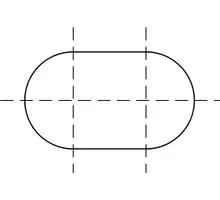 The Italian word ovolo derived, in our language , from oval . This is what a closed curve is called, similar to an ellipse, which is rounded and convex .
The Italian word ovolo derived, in our language , from oval . This is what a closed curve is called, similar to an ellipse, which is rounded and convex .
Ovals have one or two axes of symmetry. Among their properties , it can be mentioned that they lack ties and loops and that the orientation of their curvature does not register changes in sign. On the other hand, the interior of the oval is a convex set .
The aforementioned absence of ties and loops leads us to define the oval as a Jordan curve , developed from a theorem of the same name from the beginning of the 20th century. Regarding the constancy of the sign, it can be expressed as if its curvature is negative or positive, but it cannot alternate the two signs since it does not have clefts or setbacks in its structure.
Eggs are the best known case of ovals. Both bird eggs and those made with chocolate for Easter have this shape. Athletics tracks also usually have an oval configuration.
This analogy between bird eggs and the geometric figure is nothing more than a tool to recognize it, but in no way should it be taken as an exact or technical description. It is simply true that the profile of an egg roughly resembles an oval.
In certain special cases, some ellipses and circles may be called ovals , although they have two axes of symmetry , and not just one or, as may occur, none. Although in everyday life we can use this term to describe an object whose shape is similar, for mathematics there is a formal definition that includes the oval in the group of plane curves; In this framework it is also possible to refer to oval lines or curves .
The concept of ovoid is defined as a convex three-dimensional body with a rounded shape; It can be said that an oval and its interior points form a two-dimensional ovoid. Projective geometry , the branch of mathematics that focuses on geometric figures and their properties of incidence, establishes the oval and ovoid curve using only incidence conditions (a maximum of two points can be obtained by cutting an oval or ovoid with a straight line) within the framework of the so-called quadratic set .
From the point of view of projective geometry, the oval must also meet the requirement that its boundary does not contain any point that forms a zero curvature once it is arranged in the real plane. In other words, an oval is the edge of a strictly convex group since it does not have any rectilinear segments.
 On the other hand, the circuit used in motorcycle and motorsport races whose curves are always to the same side (to the right or left) is usually called an oval. This particularity makes the circuit in question oval.
On the other hand, the circuit used in motorcycle and motorsport races whose curves are always to the same side (to the right or left) is usually called an oval. This particularity makes the circuit in question oval.
Generally, these ovals have a pair of 180° curves to the left, which are linked to two straight lines of the same length. In any case, there are other kinds of ovals (for example , with four 90° curves, two short straight lines and two long straight lines).
Depending on the length of the route, the ovals are differentiated between small ovals (up to 1600 meters), medium ovals (between 1601 and 3199 meters) and super ovals (3200 meters or more). Thanks to the speed that vehicles reach, ovals are very popular in motor sports.
The National Association for Stock Car Auto Racing ( NASCAR ) typically races on ovals. The Indianapolis Motor Speedway and Daytona International Speedway , meanwhile, are among the most famous ovals in the world .
